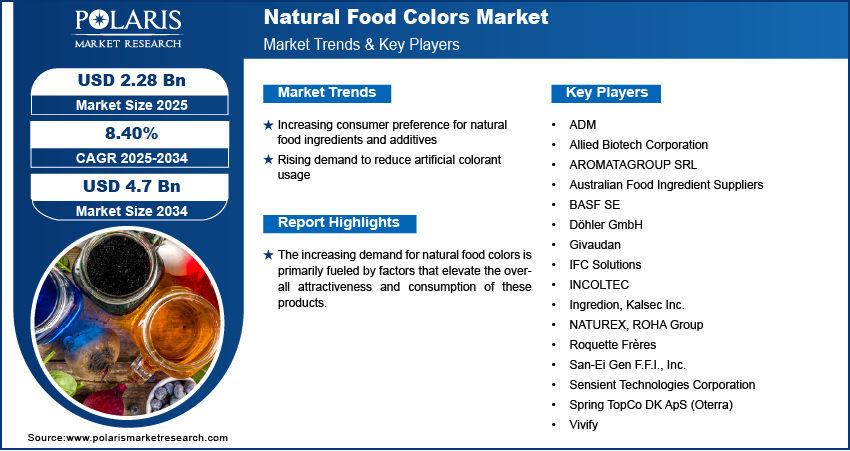Natural Food Color Market is forecasted to reach USD 4.7 billion by 2034, expanding at a CAGR of 8.40%.

The global natural food colors market was valued at USD 2.1 billion in 2024 and is forecasted to grow at a CAGR of 8.40% from 2025 to 2034. Growth is driven by rising consumer preference for clean-label and plant-based ingredients.
Key Market Trends & Insights:
- Clean Label Movement: Consumers are increasingly seeking products with natural, recognizable ingredients, boosting demand for natural colors over synthetic additives.
- Shift Toward Plant-Based Diets: As more consumers adopt plant-based diets, manufacturers are reformulating products using natural, plant-derived colorants.
- Technological Advancements in Extraction: Innovations in extraction and stabilization technologies are improving the quality, shelf-life, and heat/light resistance of natural pigments.
- Expanding Applications: Natural colors are increasingly used beyond food and beverages, in nutraceuticals, pharmaceuticals, and cosmetics.
- Focus on Sustainable Sourcing: Sustainability in sourcing raw materials (e.g., beets, spirulina, turmeric) is becoming a key focus area to meet environmental and ethical standards.
Market Size & Forecast
Market size value in 2025 USD – 2.28 billion
Revenue forecast in 2034 USD – 4.7 billion
CAGR – 8.40% from 2025 – 2034
Request for Free Sample:
Natural Food Colors Market Overview:
The Natural Food Colors Market is experiencing steady growth due to rising consumer preference for clean-label, plant-based, and chemical-free food ingredients. Natural food colors are derived from fruits, vegetables, algae, and other natural sources, replacing synthetic dyes in a wide range of food and beverage applications.
Market Growth Drivers:
- Rising Health Awareness: Growing concern over the health risks associated with artificial food dyes is driving consumers and manufacturers toward natural alternatives.
- Regulatory Support: Stringent regulations and bans on synthetic food colors in several regions are encouraging the adoption of natural coloring agents.
- Growth in Organic & Natural Products: The global rise in organic and functional food sales fuels the demand for natural food color ingredients.
- Consumer Demand for Transparency: Increasing demand for ingredient transparency in product labeling is prompting manufacturers to switch to natural colorants.
- Emerging Market Potential: Rapid urbanization and rising disposable incomes in developing countries are driving the consumption of naturally colored processed foods.
Market Challenges:
- High Cost of Natural Colorants: Compared to synthetic dyes, Natural Food Color are more expensive to produce and procure, impacting pricing strategies.
- Stability & Shelf-Life Issues: Natural pigments often face challenges related to pH sensitivity, heat, and light stability, limiting their application in some food types.
- Supply Chain Fluctuations: Seasonal availability and variable yields of plant-based raw materials can create supply chain inconsistencies.
- Color Intensity Limitations: Natural colorants may not offer the same vibrancy or consistency as synthetic alternatives, which can affect consumer appeal.
- Regulatory Variations: Different regional standards and approval processes for natural colors may restrict international market expansion.






